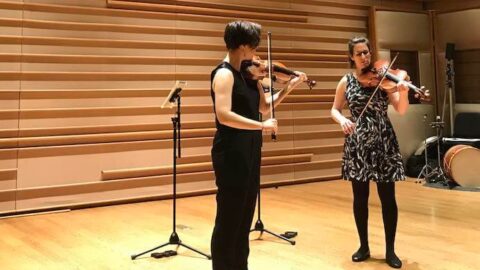Despite the icy cold winter day outside, a still and quiet warmth filled Benzaquen Hall at The DiMenna Center on December 14, 2017, creating an intimate chamber music salon. The stacks of chairs and stands in the corner of the small and unassuming room combined with the lack of printed program made for a relaxed evening that foregrounded the music and performance.
Karl Larson and Ravi Kittappa’s Permutations, a new music series based in both New York City and San Francisco, aims to present a wide variety of contemporary music. Permutations121417 did just that. By bringing together New York-based duo andPlay (Maya Bennardo, violin and Hannah Levinson, viola) with an improvising quartet (Dana Jessen, bassoon, Erica Dicker, violin, Taylor Ho Bynum, cornet, and Michael Vatcher, percussion), the carefully curated program highlighted two disparate styles of contemporary music, but also brought to light their similarities.

On the first half, andPlay presented four works they have commissioned in the last two years. In addition to being enthusiastic champions for new music and collaboration, andPlay performs with a welcoming and dynamic spirit. The duo opened with Kristofer Svensson‘s quiet Den intimitet som finns i smultron (The intimacy of wild strawberries), which they executed with thoughtfulness and care that pulled the audience in, allowing us to feel a part of a collective introspection. The opening gesture uses the breath-like quality of harmonics to evoke a specific kind of chilly stillness. As this gesture unfolds, the violin and viola move together through a series of melodic fragments, separated by pure silence. The fragments build upon each other, with each fluttery vocalism becoming more conversational. Just when I felt I had been entirely enveloped in this world, single sustained pitches faded as both performers muted the sound with their fingers and drew the bow across the string, almost as if they disappeared into the bleak expanse they had just created.
The intimate concert experience became even more warm and personal when andPlay moved in front of their stands to perform the New York premiere of Ravi Kittappa’s Tacit without music. The work includes a set of transitions for the performers to travel through, which, as the composer describes, necessitate a “keen understanding of each other’s playing and an capability for ‘tacit’ communication.” Here, andPlay’s synergy was key. Kittappa utilizes the full capability of the instruments, incorporating widely different textures such as bowing the wood of the instrument for a windy effect or quietly dropping the bow for a bouncing saltando. Throughout the work, hushed, slow figures emerge and quickly expand, becoming faster and more aggressive until the insistence of the ideas seems more important than the ideas themselves.
Stillness and silence also permeated Leaha Maria Villarreal’s Ghosting, but as the title suggests, here evoked a more haunting atmosphere. Villarreal’s exploration of the “permanence or impermanence of our connection to people” creates a work that is both eerie and beautiful. andPlay brought this idea to life as they traded a breathy figure back and forth until occasional moments of harmony or fragments of melody appeared, enveloped you, and then transitioned into another realm.

The final work of the set was the world premiere of Scott Wollschleger’s Violain, which proved that intimacy does not only have to be soft and still. Violain is built with repeated cells, made of similar sounds or gestures that are linked, using as Wollschleger describes, a collage technique. These fragmented cells expand, becoming increasingly conversational. andPlay’s technical mastery and dynamic performance shone through varied techniques—a descending pizzicato slide, active circular bowing, rapid high-pitched murmurings, and resonant chords with full vibrato. Wollschleger seamlessly integrates juxtapositions of extremes in volume, speed and timbre, creating a wild ride.
After a brief pause, the unlikely combination of bassoon, violin, cornet, and percussion took the stage for a set of improvisations. The vast array of sounds and textures from these four instruments created a unique aural experience. The visual component was equally compelling as each performer explored the full capability of their instruments. Ho Bynum’s variety of cornet mutes, Jessen’s vocalisms, Decker’s use of different tools (most notably a string of beads), and Vatcher’s expanded drum-set all provided unusually contrasting images. In improvisation, reading the body language of one’s fellow performers is usually vital, but this quartet performed largely with their eyes closed, almost as if the four musicians were moving through their own worlds. Intimacy took on a new light here, as I was unsure whether I was watching a performance or private moment.
The sound fragments and unusual techniques settled into a calm stasis as the percussion dropped out, bassoon became very quiet, violin tremolo shimmered, and a muted cornet evoked a far-off birdcall. In this way, the improvising quartet and andPlay became linked through a shared sensibility toward stillness and silence.
























